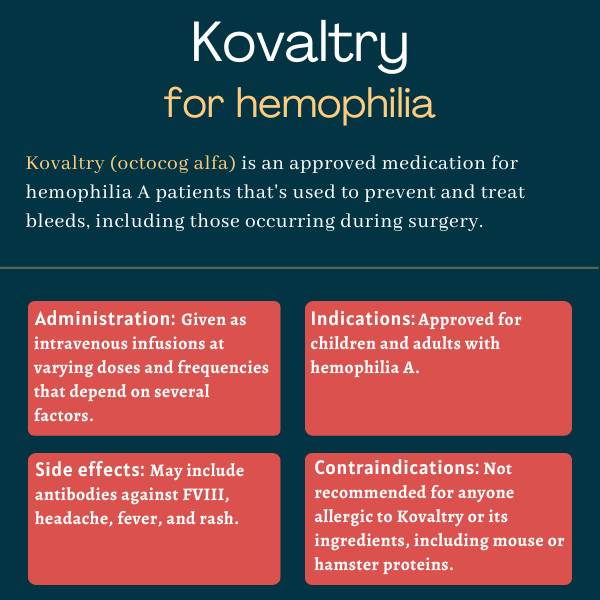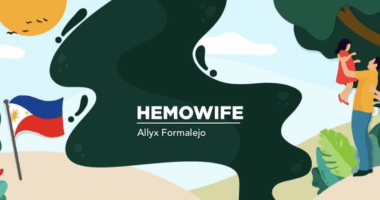Kovaltry (octocog alfa) for hemophilia
What is Kovaltry for hemophilia?
Kovaltry (octocog alfa) is a recombinant, or man-made, antihemophilic factor therapy that is approved to prevent and treat bleeding episodes, including those occurring during surgery, in adults and children with hemophilia A.
The therapy, previously known as BAY 81-8973, was developed and is now being marketed by Bayer. It is administered via an intravenous or into-the-vein infusion.
Therapy snapshot
| Brand name: | Kovaltry |
| Chemical name: | Octocog alfa |
| Usage: | Prevention and treatment of bleeds, including those occurring during surgery, in hemophilia A |
| Administration: | Intravenous infusion |
How does Kovaltry work?
Hemophilia A is an inherited bleeding disorder caused by a mutation in the F8 gene, which provides instructions for making a blood clotting protein called factor VIII (FVIII). A deficiency in this protein causes patients to bleed excessively, sometimes for no apparent reason.
Octocog alfa, Kovaltry’s active substance, is a lab-made version of FVIII that’s engineered to be identical to the protein naturally found in the body. By replacing the missing protein, Kovaltry is expected to help restore normal blood clotting, and prevent excessive bleeding in hemophilia A patients.
The active substance in Kovaltry is the same one that was used in Bayer’s Kogenate, an approved but now discontinued treatment for hemophilia A. Kovaltry, however, is produced using different manufacturing techniques.
This therapy is made by inserting the gene for octocog alfa into cells from hamsters that are grown in the lab. That enables the cells to produce the blood clotting protein, which can then be extracted, purified, and used therapeutically.
While the active substance is also the same as that used in Takeda’s approved therapy Advate, Kovaltry has a 16% longer half-life — the time it takes for the levels of a molecule to drop by half in the blood.
Who can take Kovaltry?
Kovaltry was first approved by the European Commission in February 2016, which was followed by an approval by the U.S. Food and Drug Administration in March of that year.
The medication is indicated for the treatment and control of bleeds, including those occurring during surgery, in adults and children with hemophilia A. It also may be used as a routine preventive treatment (prophylaxis) to lower bleed frequency.
Kovaltry also is similarly approved in other countries, including Canada, China, and Japan.
Who should not take Kovaltry?
Kovaltry is contraindicated, or not recommended, for patients who have experienced allergic reactions, including severe and potentially life-threatening reactions to:
- mouse or hamster proteins
- the therapy’s active ingredient
- other constituents of Kovaltry, such as glycine, sucrose, sodium chloride, calcium chloride, histidine, and polysorbate 80.
The therapy also is not indicated for the treatment of von Willebrand disease, another inherited bleeding disorder.
How is Kovaltry administered?
Kovaltry is given via an intravenous infusion. It is supplied as a dry white to slightly yellow powder in single-use vials that should be reconstituted, or diluted, in sterile water, using the components provided in the package, prior to the infusion.
The medication comes in five different dosage strengths of FVIII, expressed in international units, or IUs. They are labeled and color-coded:
- Blue is used for the 250 IU dosage strength.
- Green marks the 500 IU dose.
- Red marks the 1,000 IU dosage strength.
- Yellow is for the 2,000 IU dosage strength.
- Gray is the 3,000 IU dosage strength.
For routine prophylaxis in adults, and in adolescents ages 13 and older, Kovaltry should be administered at a dose of 20 to 40 IU per kilogram of body weight two or three times weekly. For children ages 12 or younger, the recommended dose is 25 to 50 IU/kg two or three times weekly, or every other day.
For on-demand treatment, Kovaltry is recommended to be given to maintain FVIII activity levels at:
- 20 to 40 IU/dL, with dosing every 12-24 hours for at least one day, should be used until pain is resolved or healing is achieved in the case of minor bleeds (e.g., minor muscle or oral bleeds)
- 30 to 60 IU/dL, with dosing every 12-24 hours for three to four days, should be given until pain and acute disability are resolved in the case of moderate bleeds (e.g., more extensive joint or muscle bleeds)
- 60 to 100 IU/dL, with dosing every 8-24 hours, should be administered until bleeding resolves in the case of major bleeds (e.g., life-threatening bleeds or those occurring in the brain or gastrointestinal tract).
For minor surgical procedures, such as tooth extraction, Kovaltry should be given every 24 hours for at least one day to maintain FVIII activity levels at 30 to 60 IU/dL, until healing is achieved.
For major surgical procedures, such as joint replacement surgery or surgery involving the brain, Kovaltry should be given every 8-24 hours to maintain FVIII activity levels at 80 to 100 IU/dL until healing is achieved. The therapy then should be given for at least seven more days to maintain FVIII activity levels at 30 to 60 IU/dL.
Dosing may be adjusted at a healthcare provider’s discretion based on the individual patient’s case and various clinical factors.
Patients or caregivers may infuse Kovaltry after receiving proper training from a healthcare professional or hemophilia treatment center. Individuals who have not been trained should never attempt to self-infuse Kovaltry.
After reconstitution, Kovaltry should be administered as soon as possible. If not used immediately, the treatment should be stored at room temperature for up to three hours. Infusion usually takes 1-15 minutes, and the rate of administration should be adapted to each patient’s response.

Kovaltry in clinical trials
Kovaltry’s approvals were supported by data from three international Phase 3 trials, all dubbed LEOPOLD. These were the LEOPOLD 1 (NCT01029340) and LEOPOLD 2 (NCT01233258) trials, both involving male adults and adolescents, and the LEOPOLD Kids (NCT01311648) study in boys 12 and younger.
LEOPOLD 1 trial
LEOPOLD 1 assessed the safety and efficacy of Kovaltry over a one-year period in 62 boys and men with severe hemophilia A, ages 12-65. Patients were randomly assigned a dose between 20 and 50 IU/kg, to be taken two or three times a week as a prophylactic treatment. The participants also were treated with Kovaltry as an on-demand treatment for spontaneous bleeds.
The study’s results confirmed that Kovaltry was safe and effective at preventing and treating bleeds. Median annualized bleed rates were similar in patients receiving prophylactic treatment twice or three times weekly, with one or two bleeds per year, respectively. Additionally, two or fewer infusions of Kovaltry were sufficient to resolve 87% of the bleeds.
LEOPOLD 2 trial
Involving 80 male patients, ages 12-65, with severe hemophilia A, LEOPOLD 2 was designed to compare the effects of Kovaltry when used as an on-demand and as a prophylactic treatment. These results demonstrated that prophylaxis was significantly more effective, reducing the median annualized bleed rate by 97% compared with on-demand treatment.
LEOPOLD Kids trial
The LEOPOLD Kids trial sought to evaluate the safety and efficacy of Kovaltry as a prophylactic treatment in children with severe hemophilia A, who also could receive on-demand treatment with the medication if they experienced any bleeds. The trial, which involved 51 patients, showed that Kovaltry was well tolerated and effective at treating and preventing bleeds in younger patients.
Previously-treated children had a median annualized bleed rate of two bleeds per year over the course of the six-month study. That rate was similar in patients receiving prophylactic treatment twice or three times weekly. The median annualized bleed rate within 48 hours of receiving prophylactic treatment was zero.
Two or fewer infusions of Kovaltry were sufficient to resolve nearly 90% of bleeds in previously-treated children, the results showed.
The safety and efficacy of Kovaltry during surgery also were assessed as part of the LEOPOLD trials. Altogether, 44 patients — both adults and children — underwent a total of 60 minor and major surgeries while receiving Kovaltry. The patients, overall, did not experience blood loss outside the expected range for surgery. Accordingly, these results demonstrated that Kovaltry can successfully control bleeding during surgery.
Common side effects of Kovaltry
The most common side effects associated with Kovaltry, as reported in clinical trials, include:
- FVIII antibodies, or inhibitors, in previously untreated or minimally treated patients
- fever
- headache
- rash.
Allergic reactions
Patients may develop allergic reactions, including life-threatening ones known as anaphylaxis, when treated with Kovaltry. The medication contains traces of mouse and hamster proteins, so it may cause allergic reactions in patients who have any allergies to such proteins.
If patients experience symptoms of an allergic reaction, such as chest tightness, dizziness, low blood pressure, or nausea, Kovaltry should be stopped immediately and a healthcare professional contacted.
Development of inhibitors
With long-term use, patients may develop neutralizing antibodies, or inhibitors, against Kovaltry, which can lower its effectiveness. Those who have not been previously treated are at the highest risk of developing inhibitors.
Patients should be monitored for the development of inhibitors. If expected FVIII levels are not attained or bleeding is not controlled as expected, patients should be evaluated for possible inhibitors.
Injection site infections
For patients who require frequent infusions, Kovaltry may be administered via a central venous catheter, or a tube implanted in a large vein. Infections at the catheter site may occur. These infections usually are not related to the treatment itself.
Cardiovascular events
As cardiovascular events often involve abnormal blood clotting, hemophilia patients may be at a lower risk of experiencing such incidences than are people in the general population.
However, patients with cardiovascular risk factors may be at a similar risk of developing cardiovascular disease as are non-hemophilic patients once blood clotting has been normalized by treatment with Kovaltry.
Use in pregnancy and breastfeeding
It is unknown if Kovaltry can affect a developing fetus during pregnancy or be passed on to a nursing infant through breast milk. Patients who are pregnant, plan to become pregnant, or are breastfeeding or plan to breastfeed while receiving treatment with Kovaltry should talk with their healthcare team.
Hemophilia News Today is strictly a news and information website about the disease. It does not provide medical advice, diagnosis or treatment. This content is not intended to be a substitute for professional medical advice, diagnosis, or treatment. Always seek the advice of your physician or other qualified health provider with any questions you may have regarding a medical condition. Never disregard professional medical advice or delay in seeking it because of something you have read on this website.
Recent Posts
Related articles

 Fact-checked by
Fact-checked by 


